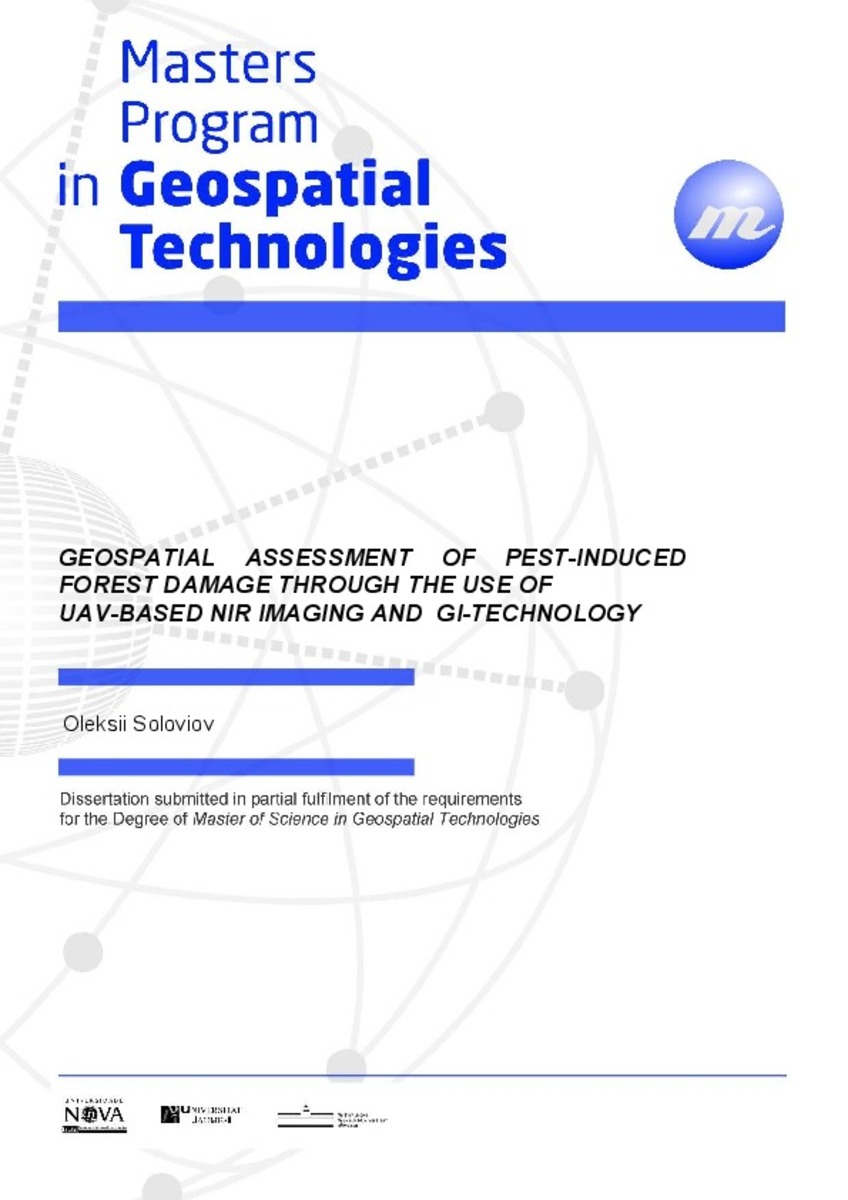Mostrar el registro sencillo del ítem
Geospatial assessment of pest-induced forest damage through the use of UAV-based NIR imaging and GI-technology
| dc.contributor | Pla Bañón, Filiberto | |
| dc.contributor | Caetano, Mário | |
| dc.contributor | Prinz, Torsten | |
| dc.contributor.author | Soloviov, Oleksii | |
| dc.contributor.other | Universitat Jaume I. Departament de Llenguatges i Sistemes Informàtics | |
| dc.date.accessioned | 2016-04-19T07:06:26Z | |
| dc.date.available | 2016-04-19T07:06:26Z | |
| dc.date.issued | 2014-02-28 | |
| dc.identifier.uri | http://hdl.handle.net/10234/158860 | |
| dc.description | Treball final de Màster Universitari Erasmus Mundus en Tecnologia Geoespacial. Codi: SIW013. Curs acadèmic 2013-2014 | ca_CA |
| dc.description.abstract | Every year oak forests become infected by populations of the splendor beetle (Agrilus bigutattus). The detection and monitoring of infected trees is important, because of economic and ecological reasons. Traditional approach to detect the pest infestation level of each tree is performed by using ground-based observation method. It is long and ineffective method because of limitations, such as: poor visibility of the highest trees and impenetrability of some forest plots. The main goal is to identify infected oaks trees by splendor beetle at the 2 study areas. Pest-infested oak trees by splendor beetle are characterized by high level of defoliation and different reflection signatures. These features can be detected by using very high resolution color infrared (CIR) images. In August 2013 it was performed flight campaign by using unmanned aerial systems (UAS). CIR images were covering 2 test sites in rural area, near city Soest (Germany). Study areas represents small, privately owned oaks forest plots. In this research was used a small quadrocopter (Microdrone MD4-200) with vertical takeoff and landing capability (VTOL). Microdrone is carried a digital camera (Canon PowerShot SD 780 IS). Additionally, camera was modified to capture not just a visible spectrum, but also NIR spectrum (400 to 1100 nm) of infected oaks. The proposed workflow includes the CIR image acquisition, image stitching, radiometric correction, georeferencing, modified vegetation indices calculation, pixel based and object-based image classification and accuracy assessment. Images were classified using 5 classes (healthy, low infected, high infected, died trees and canopy gaps). Finally, the results can be integrated with existing WMS service. Applying of UAV make possible to obtain multitemporal data, which facilitates monitoring and detection of infected trees. The work was performed in close cooperation with the Forestry Department of Soest (Germany). | ca_CA |
| dc.format.extent | XII, 62 p. | ca_CA |
| dc.format.mimetype | application/pdf | ca_CA |
| dc.language.iso | eng | ca_CA |
| dc.publisher | Universitat Jaume I | ca_CA |
| dc.rights | Attribution-NonCommercial-ShareAlike 4.0 Spain | * |
| dc.rights.uri | http://creativecommons.org/licenses/by-nc-sa/4.0/ | * |
| dc.subject | Màster Universitari Erasmus Mundus en Tecnologia Geoespacial | ca_CA |
| dc.subject | Erasmus Mundus University Master's Degree in Geospatial Technologies | ca_CA |
| dc.subject | Máster Universitario Erasmus Mundus en Tecnología Geoespacial | ca_CA |
| dc.subject | Color-infrared Images (CIR) | ca_CA |
| dc.subject | Near-infrared Images (NIR) | ca_CA |
| dc.subject | Object-based Classification | ca_CA |
| dc.subject | Pest infestation | ca_CA |
| dc.subject | Pixel-based classification | ca_CA |
| dc.subject | Principal component | ca_CA |
| dc.subject | Unmanned eerial vehicle | ca_CA |
| dc.subject | Vegetation indices | ca_CA |
| dc.subject | Very high resolution images | ca_CA |
| dc.title | Geospatial assessment of pest-induced forest damage through the use of UAV-based NIR imaging and GI-technology | ca_CA |
| dc.type | info:eu-repo/semantics/masterThesis | ca_CA |
| dc.educationLevel | Estudios de Postgrado | ca_CA |
| dc.rights.accessRights | info:eu-repo/semantics/openAccess | ca_CA |
Ficheros en el ítem
Este ítem aparece en la(s) siguiente(s) colección(ones)
-
TFM: Màster Universitari Erasmus Mundus en Tecnologia Geoespacial [79]
SIW013; SIK013








